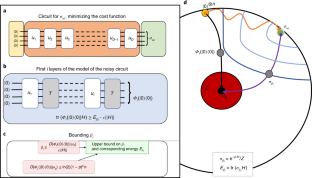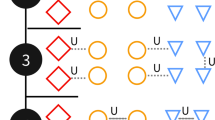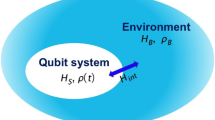Abstract
Recent successes in producing intermediate-scale quantum devices have focused interest on establishing whether near-term devices could outperform classical computers for practical applications. A central question is whether noise can be overcome in the absence of quantum error correction or if it fundamentally restricts any potential quantum advantage. We present a transparent way of comparing classical and quantum algorithms running on noisy devices for a large family of tasks that includes optimization and variational eigenstate solving. Our approach is based on entropic inequalities that determine how fast the quantum state converges to the fixed point of the noise model, together with established classical methods of Gibbs state simulation. Our techniques are extremely versatile and so may be applied to a large variety of algorithms, noise models and quantum computing architectures. We use our result to provide estimates for problems within reach of current experiments, such as quantum annealers or variational quantum algorithms. The bounds we obtain indicate that substantial quantum advantages are unlikely for classical optimization unless noise rates are decreased by orders of magnitude or the topology of the problem matches that of the device. This is the case even if the number of available qubits increases substantially.
This is a preview of subscription content, access via your institution
Access options
Access Nature and 54 other Nature Portfolio journals
Get Nature+, our best-value online-access subscription
$29.99 / 30 days
cancel any time
Subscribe to this journal
Receive 12 print issues and online access
$209.00 per year
only $17.42 per issue
Buy this article
- Purchase on Springer Link
- Instant access to full article PDF
Prices may be subject to local taxes which are calculated during checkout





Similar content being viewed by others
Data availability
All data that support the plots within this paper and other findings of this study are available from the corresponding authors upon reasonable request.
Code availability
The code for this study can be found at ref. 62.
References
Arute, F. et al. Quantum supremacy using a programmable superconducting processor. Nature 574, 505–510 (2019).
Preskill, J. Quantum computing in the NISQ era and beyond. Quantum 2, 79 (2018).
Peruzzo, A. et al. A variational eigenvalue solver on a photonic quantum processor. Nat. Commun. 5, 4213 (2014).
Kokail, C. et al. Self-verifying variational quantum simulation of lattice models. Nature 569, 355–360 (2019).
Jones, T., Endo, S., McArdle, S., Yuan, X. & Benjamin, S. C. Variational quantum algorithms for discovering Hamiltonian spectra. Phys. Rev. A 99, 062304 (2019).
LaRose, R., Tikku, A., O’Neel-Judy, É., Cincio, L. & Coles, P. J. Variational quantum state diagonalization. npj Quantum Inf. 5, 57 (2019).
Bravo-Prieto, C. et al. Variational quantum linear solver. Preprint at https://arxiv.org/abs/1909.05820 (2019).
McArdle, S. et al. Variational ansatz-based quantum simulation of imaginary time evolution. npj Quantum Inf. 5, 75 (2019).
Moll, N. et al. Quantum optimization using variational algorithms on near-term quantum devices. Quantum Sci. Technol. 3, 030503 (2018).
Kandala, A. et al. Hardware-efficient variational quantum eigensolver for small molecules and quantum magnets. Nature 549, 242–246 (2017).
Wang, D., Higgott, O. & Brierley, S. Accelerated variational quantum eigensolver. Phys. Rev. Lett. 122, 140504 (2019).
Farhi, E., Goldstone, J. & Gutmann, S. A quantum approximate optimization algorithm. Preprint at https://arxiv.org/abs/1411.4028 (2014).
Farhi, E., Goldstone, J., Gutmann, S. & Sipser, M. Quantum computation by adiabatic evolution. Preprint at https://arxiv.org/abs/quant-ph/0001106 (2000).
Albash, T. & Lidar, D. A. Adiabatic quantum computation. Rev. Mod. Phys. 90, 015002 (2018).
Lucas, A. Ising formulations of many NP problems. Front. Phys. https://doi.org/10.3389/fphy.2014.00005 (2014).
Carbone, R. & Martinelli, A. Logarithmic sobolev inequalities in non-commutative algebras. Infin. Dimens. Anal. Quantum Probab. Relat. Top. 18, 1550011 (2015).
Kastoryano, M. J. & Brandão, F. G. S. L. Quantum Gibbs samplers: the commuting case. Commun. Math. Phys. 344, 915–957 (2016).
Beigi, S., Datta, N. & Rouzé, C. Quantum reverse hypercontractivity: its tensorization and application to strong converses. Commun. Math. Phys. 376, 753–794 (2020).
Bardet, I., Capel, Á., Lucia, A., Pérez-García, D. & Rouzé, C. On the modified logarithmic Sobolev inequality for the heat-bath dynamics for 1D systems. J. Math. Phys. 62, 061901 (2021).
Capel, Á., Rouzé, C. & França, D. S. The modified logarithmic Sobolev inequality for quantum spin systems: classical and commuting nearest neighbour interactions. Preprint at https://arxiv.org/abs/2009.11817 (2020).
Müller-Hermes, A., França, D. S. & Wolf, M. M. Relative entropy convergence for depolarizing channels. J. Math. Phys. 57, 022202 (2016).
Tsuda, K., Rätsch, G. & Warmuth, M. K. Matrix exponentiated gradient updates for on-line learning and Bregman projection. J. Mach. Learn. Res. 6, 995–1018 (2005).
Bubeck, S. Convex optimization: algorithms and complexity. Found. Trends Mach. Learn. 8, 231–357 (2015).
Aaronson, S., Chen, X., Hazan, E., Kale, S. & Nayak, A. Online learning of quantum states. J. Stat. Mech. Theory Exp. 2019, 124019 (2019).
Aaronson, S. Shadow tomography of quantum states. In Proc. 50th Annual ACM SIGACT Symposium on Theory of Computing - STOC 2018 https://doi.org/10.1145%2F3188745.3188802 (ACM Press, 2018).
Brandão, F. G. et al. Quantum SDP solvers: large speed-ups, optimality, and applications to quantum learning. DROPS https://doi.org/10.4230/lipics.icalp.2019.27 (2019).
Brandão, F. G. S. L., Kueng, R. & França, D. S. Faster quantum and classical sdp approximations for quadratic binary optimization. Preprint at https://arxiv.org/abs/1909.04613 (2019).
Youssry, A., Ferrie, C. & Tomamichel, M. Efficient online quantum state estimation using a matrix-exponentiated gradient method. New J. Phys. 21, 033006 (2019).
Crosson, E. & Slezak, S. Classical simulation of high temperature quantum Ising models. Preprint at https://arxiv.org/abs/2002.02232 (2020).
Harrow, A., Mehraban, S. & Soleimanifar, M. Classical algorithms, correlation decay, and complex zeros of partition functions of quantum many-body systems. In Proc. 52nd Annual ACM SIGACT Symposium on Theory of Computing (STOC 2020) https://doi.org/10.1145/3357713.3384322 (ACM, 2020).
Kuwahara, T., Kato, K. & Brandão, F. G. Clustering of conditional mutual information for quantum gibbs states above a threshold temperature. Phys. Rev. Lett. https://doi.org/10.1103/PhysRevLett.124.220601 (2020).
Verstraete, F., García-Ripoll, J. J. & Cirac, J. I. Matrix product density operators: Simulation of finite-temperature and dissipative systems. Phys. Rev. Lett. 93, 207204 (2004).
Foulkes, W. M. C., Mitas, L., Needs, R. J. & Rajagopal, G. Quantum Monte Carlo simulations of solids. Rev. Mod. Phys. 73, 33–83 (2001).
Rigol, M., Bryant, T. & Singh, R. R. P. Numerical linked-cluster approach to quantum lattice models. Phys. Rev. Lett. 97, 187202 (2006).
Tang, B., Khatami, E. & Rigol, M. A short introduction to numerical linked-cluster expansions. Comput. Phys. Commun. 184, 557–564 (2013).
White, S. R. Minimally entangled typical quantum states at finite temperature. Phys. Rev. Lett. 102, 190601 (2009).
Molnar, A., Schuch, N., Verstraete, F. & Cirac, J. I. Approximating Gibbs states of local Hamiltonians efficiently with projected entangled pair states. Phys. Rev. B 91, 045138 (2015).
Kliesch, M., Gogolin, C., Kastoryano, M., Riera, A. & Eisert, J. Locality of temperature. Phys. Rev. X 4, 031019 (2014).
Harrigan, M. P. et al. Quantum approximate optimization of non-planar graphÿ problems on a planar superconducting processor. Nat. Phys. 17, 332–336 (2021).
Levin, D. A. & Peres, Y. Markov Chains and Mixing Times Vol. 107 (American Mathematical Society, 2017).
Eldan, R., Koehler, F. & Zeitouni, O. A spectral condition for spectral gap: fast mixing in high-temperature Ising models. Preprint at https://arxiv.org/abs/2007.08200 (2020).
Aharonov, D., Ben-Or, M., Impagliazzo, R. & Nisan, N. Limitations of noisy reversible computation. Preprint at http://arxiv.org/abs/quant-ph/9611028 (1996).
Ben-Or, M., Gottesman, D. & Hassidim, A. Quantum refrigerator. Preprint at http://arxiv.org/abs/1301.1995 (2013).
Muller-Hermes, A., Reeb, D. & Wolf, M. M. Quantum subdivision capacities and continuous-time quantum coding. IEEE Trans. Inform. Theory 61, 565–581 (2015).
Razborov, A. A. An upper bound on the threshold quantum decoherence rate. Preprint at http://arxiv.org/abs/quant-ph/0310136 (2003).
Plenio, M. B. & Virmani, S. Upper bounds on fault tolerance thresholds of noisy Clifford-based quantum computers. New J. Phys. 12, 033012 (2010).
Kempe, J., Regev, O., Unger, F. & de Wolf, R. in Automata, Languages and Programming Vol. 5125 (eds Aceto, L. et al.) 845–856 (Springer, 2008).
Buhrman, H. et al. New limits on fault-tolerant quantum computation. In 2006 47th Annual IEEE Symposium on Foundations of Computer Science (FOCS’06) 411–419 (IEEE, 2006).
Hadlock, F. Finding a maximum cut of a planar graph in polynomial time. SIAM J. Comput. 4, 221–225 (1975).
Johnson, M. W. et al. Quantum annealing with manufactured spins. Nature 473, 194–198 (2011).
Technical Description of the D-wave Quantum Processing Unit (D-Wave Systems, 2019).
Ye, Y. Gset Random Graphs (CISE, 2015); https://www.cise.ufl.edu/research/sparse/matrices/Gset/
Yurtsever, A., Tropp, J. A., Fercoq, O., Udell, M. & Cevher, V. Scalable semidefinite programming. J. Math. Data Sci. 3, 171–200 (2021).
Isakov, S., Zintchenko, I., Rønnow, T. & Troyer, M. Optimised simulated annealing for ising spin glasses. Comput. Phys. Commun. 192, 265–271 (2015).
Bardet, I. & Rouzé, C. Hypercontractivity and logarithmic sobolev inequality for non-primitive quantum markov semigroups and estimation of decoherence rates. Preprint at https://arxiv.org/abs/1803.05379 (2018).
Bremner, M. J., Montanaro, A. & Shepherd, D. J. Achieving quantum supremacy with sparse and noisy commuting quantum computations. Quantum 1, 8 (2017).
Job, J. & Lidar, D. Test-driving 1000 qubits. Quantum Sci. Technol. 3, 030501 (2018).
Kochenberger, G. A., Hao, J.-K., Lü, Z., Wang, H. & Glover, F. Solving large scale Max Cut problems via tabu search. J. Heuristics 19, 565–571 (2013).
Albash, T. & Lidar, D. A. Decoherence in adiabatic quantum computation. Phys. Rev. A 91, 062320 (2015).
Kastoryano, M. J. & Temme, K. Quantum logarithmic Sobolev inequalities and rapid mixing. J. Math. Phys.54, 052202 (2013).
Olkiewicz, R. & Zegarlinski, B. Hypercontractivity in noncommutative Lp spaces. J. Funct. Anal. 161, 246–285 (1999).
Franca, D. S. Limitations optimization plots. GitHub https://github.com/dsfranca/limitations_optimization_plots (2020).
Acknowledgements
D.S.F. was supported by VILLUM FONDEN via the QMATH Centre of Excellence under grant no. 10059. R.G.-P. was supported by the Quantum Computing and Simulation Hub, an EPSRC-funded project, part of the UK National Quantum Technologies Programme. We thank H. Guo, J. Brown-Cohen and P.-L. Dallaire-Demers for helpful discussions.
Author information
Authors and Affiliations
Contributions
Both authors discussed the results and contributed to the writing and theory development for the final manuscript.
Corresponding authors
Ethics declarations
Competing interests
The authors declare no competing interests.
Additional information
Peer review information Nature Physics thanks Marco Tomamichel and the other, anonymous, reviewer(s) for their contribution to the peer review of this work.
Publisher’s note Springer Nature remains neutral with regard to jurisdictional claims in published maps and institutional affiliations.
Supplementary information
Supplementary information
Supplementary Discussion and Fig. 1.
Rights and permissions
About this article
Cite this article
Stilck França, D., García-Patrón, R. Limitations of optimization algorithms on noisy quantum devices. Nat. Phys. 17, 1221–1227 (2021). https://doi.org/10.1038/s41567-021-01356-3
Received:
Accepted:
Published:
Issue Date:
DOI: https://doi.org/10.1038/s41567-021-01356-3
This article is cited by
-
Quantifying the effect of gate errors on variational quantum eigensolvers for quantum chemistry
npj Quantum Information (2024)
-
Realization of quantum signal processing on a noisy quantum computer
npj Quantum Information (2023)
-
Out-of-distribution generalization for learning quantum dynamics
Nature Communications (2023)
-
Theory of overparametrization in quantum neural networks
Nature Computational Science (2023)
-
A semi-agnostic ansatz with variable structure for variational quantum algorithms
Quantum Machine Intelligence (2023)



